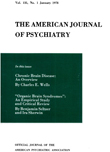NEUROPSYCHIATRY IN A GENERAL HOSPITAL
Abstract
The admission to, and the housing of an insane patient in a general hospital is not new. Complete and successful integration of the admission and the treatment of such a patient in a general hospital is new and requires not only patience and tact, but also all modern facilities for its satisfying achievement.
The administrative demands and problems of conducting a division of neuropsychiatry as part and parcel of the department of medicine in a general hospital is a challenge that should be more liberally accepted. The associated difficulties are in no sense insurmountable. The advantages to the hospital, to its lay and professional personnel, and to the mentally ill patient far outweigh the disadvantages.
[See for table VI in Source PDF]
General hospitals, thoughtful of their facilities and with careful training of their personnel and the guidance of a qualified psychiatrist, can do much to meet the problems of the returning neuropsychiatric casualties of the present war. The results of caring for neuropsychiatric patients in a general hospital are highly gratifying. Such care does relieve our state hospitals and disseminates a more wholesome understanding of the neuropsychiatric patient among our professional colleagues, and most of all, among the people that constitute the general public. Morbid fears are reduced and references to "living death" are less frequent.
Access content
To read the fulltext, please use one of the options below to sign in or purchase access.- Personal login
- Institutional Login
- Sign in via OpenAthens
- Register for access
-
Please login/register if you wish to pair your device and check access availability.
Not a subscriber?
PsychiatryOnline subscription options offer access to the DSM-5 library, books, journals, CME, and patient resources. This all-in-one virtual library provides psychiatrists and mental health professionals with key resources for diagnosis, treatment, research, and professional development.
Need more help? PsychiatryOnline Customer Service may be reached by emailing [email protected] or by calling 800-368-5777 (in the U.S.) or 703-907-7322 (outside the U.S.).



